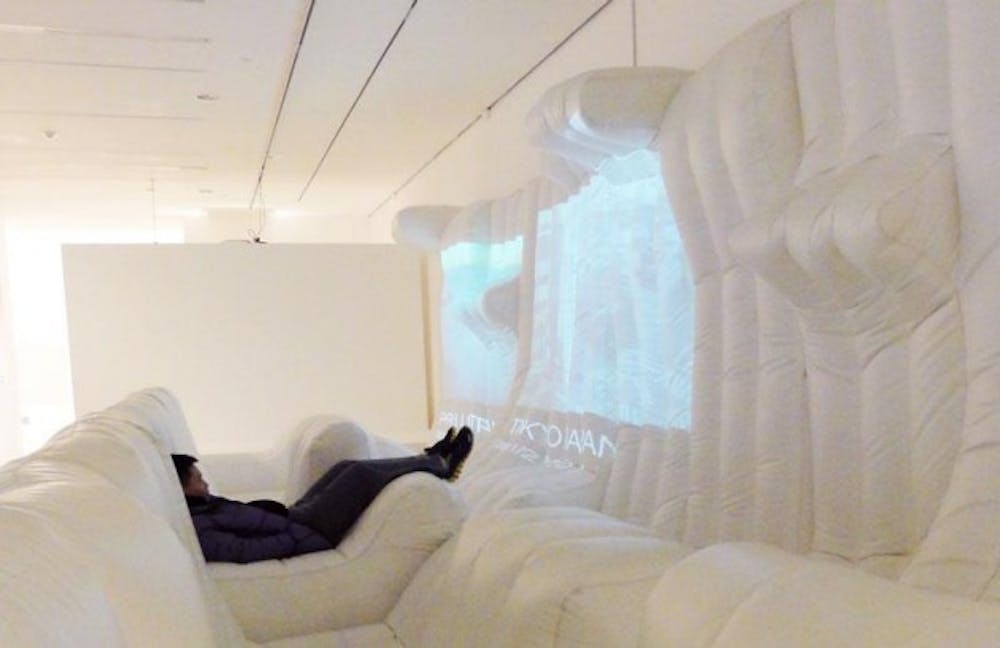Inside the Center for the Arts art gallery, a small television greets you, commanding attention from all who enter and catching the more traditional patrons by surprise.
The television, however, is not there for simple recreational purposes. It is actually Boem Kim's piece "Untitled (News)," set to repeat public service announcements from a number of Korean news broadcasts. This piece is a part of Time Mutations, a joint-exhibition hosted in the CFA gallery, which features works from Bauhaus University in Weimar, Germany and Visual Studies at UB.
And though pillows are scattered before the set to relax upon, viewers won't be sitting down for typical mindless television; subtitles on the screen describe disturbing end-of-the-world musings, requests for hair styling tips and vague generalities about the day-to-day life of the hypermodern-globalized inhabitant.
The gallery would make the likes of Fredric Jameson and William Gibson proud, combining post-modernist Internet culture with highbrow artistic expression in a surprisingly surreal exhibition. The focus, however, immediately falls upon an inflatable lounge with live global A/V feeds, suggesting viewers leave their shoes off for just another moment to relax in the grown-up, intellectualized version of a bouncy ball pit.
Potential visitors should be armed with a smartphone QR code reader as each of the artist descriptions and labels has a QR code on it. Upon scanning a code, it'll take you to a website that has more information, including videos, pictures and biographical information about the artist.
The exhibit itself looks like a romp through someone's Internet browser history with Steven Nolan's animated .gif lookalike, titled This Desert was once a Sea, projected upon the wall in full glory.
"These images were taken from Lawrence of Arabia, the epic," said Max Neupert of Bauhaus University, Weimar, and co-curator of the exhibit. "It's only 16 frames of the film, so [the subject] seems to be caught in some kind of endless loop."
Further in the gallery, Carrie Kaser's piece, titled "Daily Document," displays an actual frolic through Internet browser history with her ink pen on paper expos?(c) of Internet experience.
"[Carrie] traced everything she looked at in one browser window over one week," said Liz Flyntz, co-curator of the exhibit.
Dotted with familiar logos and browser-marks - UB Mail, Wikipedia, Google, Facebook, Expedia - the piece stylizes the seemingly mundane and pointless aspects of Internet culture into an interesting expression of form and content in HTML documents.
In the back room of the gallery, Jacob Kasey's untitled silver deposit and acrylic hangs on the wall, blurrily reflecting the viewer's image back at viewers.
"Some works don't need any information," Flyntz said. "It's more about how you experience them."
While not directly related to time dilations or broken timelines, Kasey's work holds an ambiance of its own in its curiosity and lack of content.
"It's about more than one thing at a time," said gallery framer Tom Holt. "Unlike a painting, [which is] a narrative, but only showing you a single moment in the narrative, these works are trying to elaborate more on the before, the now and the after. It's a way of over-poeticizing time."
The gallery features works in new media, technology, art and design from both UB and the digital media study program of Bauhaus University. The creativity expressed in this highly modernized form of technologic art is both fascinating and entertaining.
Admission to the gallery is open to all and free of charge until May 4.
Email: arts@ubspectrum.com





